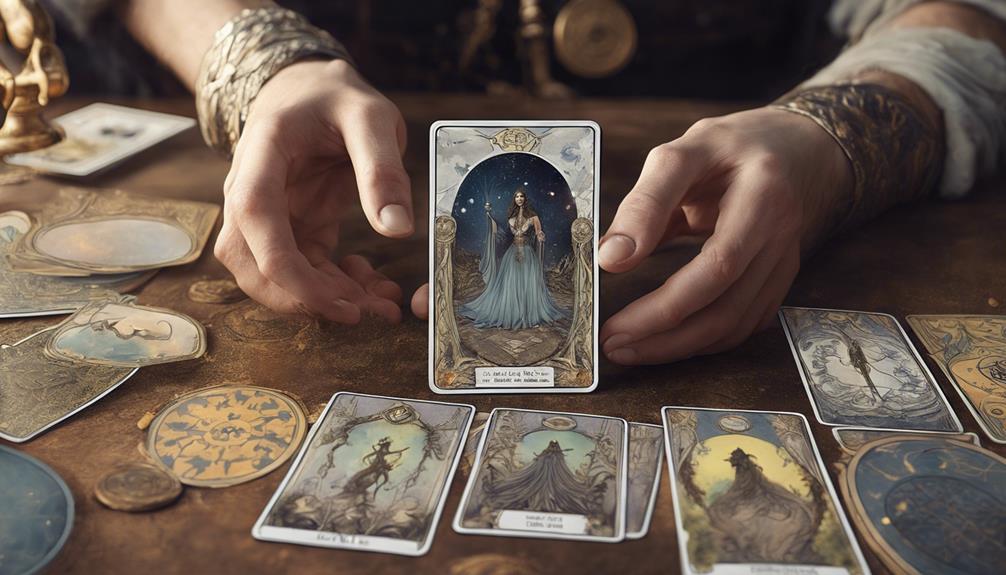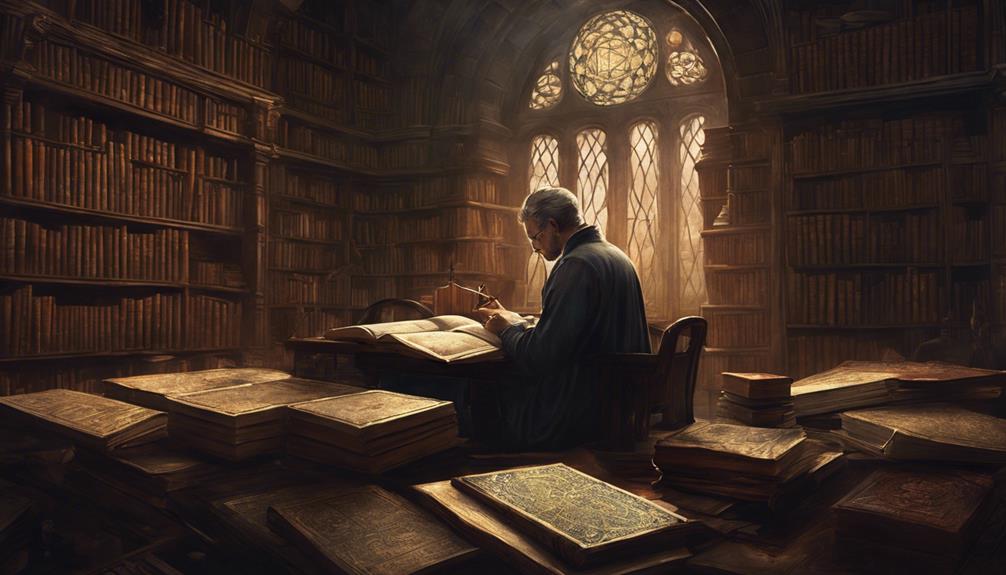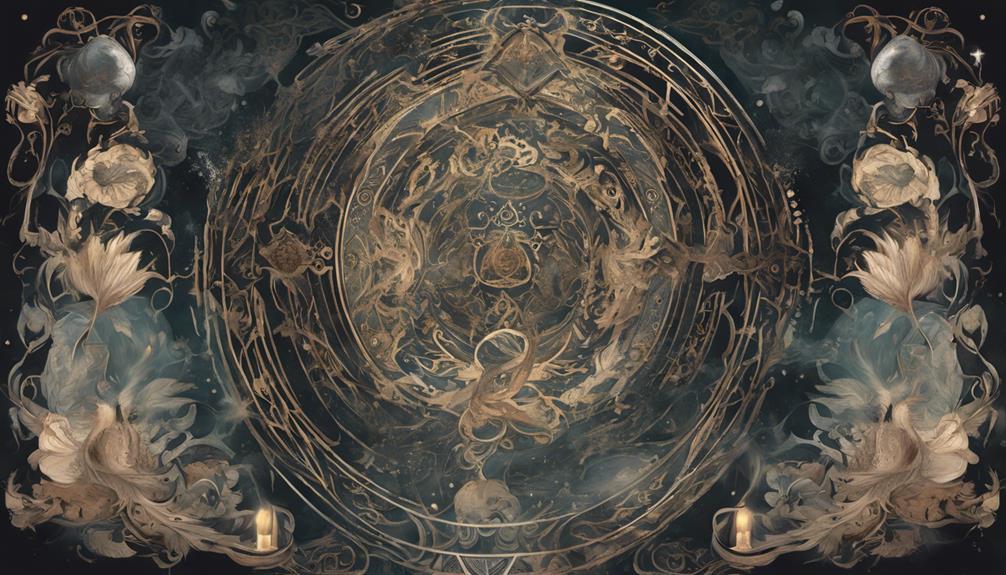How Arthur E. Waite's Scholarship Deepened Tarot's Mystique

Arthur E. Waite's scholarly work deepened Tarot's mystique by creating the iconic Rider-Waite Tarot Deck with Pamela Colman Smith. His research into symbolism and esoteric philosophy sparked a resurgence in Tarot's popularity and continues to intrigue enthusiasts.
Waite's legacy leaves an enduring impact on the Tarot landscape, inviting contemplation into the intricate meanings of each card.
Early Life and Influences
How did Arthur E. Waite's early life and influences shape his journey into the world of Tarot mystique?
Arthur Edward Waite, born on October 2, 1857, in Brooklyn, New York, was heavily influenced by his childhood experiences and early influences. Growing up in an environment that nurtured his curiosity and love for the mystical, Waite developed a deep interest in the occult from a young age. His exposure to various esoteric teachings and spiritual philosophies during his formative years laid the foundation for his later work in Tarot mystique.
Waite's early influences, including his fascination with symbolism and metaphysics, played a pivotal role in shaping his worldview and approach to Tarot. As he explored deeper into the domains of mysticism and symbolism, he sought to unravel the hidden meanings behind the Tarot cards, viewing them as more than just a mere divination tool. This early curiosity and thirst for knowledge set him on a path of exploration and discovery that would ultimately lead to his significant contributions to the world of Tarot mystique.
Collaboration With Pamela Colman Smith
Arthur E. Waite's collaboration with Pamela Colman Smith was a creative partnership that left a lasting impact on the world of Tarot.
Together, they crafted a deck that combined Waite's esoteric vision with Smith's artistic flair, revolutionizing Tarot card illustrations.
Their collaboration not only influenced the imagery of the cards but also shaped the mystical and symbolic meanings embedded within them.
Creative Partnership Dynamic
The collaboration between Arthur E. Waite and Pamela Colman Smith in creating the Tarot deck was a remarkable fusion of artistic vision and esoteric symbolism. This partnership dynamic thrived on their mutual respect and understanding, leading to a creative collaboration that transcended conventional boundaries.
- Synergy of Ideas: Waite's deep knowledge of occult traditions blended seamlessly with Smith's intuitive artistic flair.
- Shared Vision: Both artists shared a common goal of infusing the tarot cards with rich symbolism and depth.
- Open Communication: Their ability to openly exchange thoughts and ideas fostered a harmonious working relationship.
- Mutual Inspiration: Each artist inspired and challenged the other, pushing the boundaries of traditional tarot imagery.
Influences on Illustrations
Their collaborative effort not only enriched the Tarot deck with unique symbolism but also left a lasting imprint on the illustrations, showcasing a blend of their distinct artistic styles.
Pamela Colman Smith's vibrant and intuitive approach to art, influenced by the Pre-Raphaelites and the Arts and Crafts Movement, brought a whimsical and dreamlike quality to the cards.
In contrast, Arthur E. Waite's deep knowledge of occult symbolism and esoteric traditions guided the thematic elements and intricate details within the illustrations.
The fusion of Smith's free-spirited creativity and Waite's mystical insights resulted in a visually enchanting Tarot deck that continues to intrigue and inspire seekers today.
Their artistic choices not only reflected their individual talents but also harmonized to create a timeless and enigmatic masterpiece.
The Rider-Waite Tarot Deck

Influencing tarot enthusiasts worldwide, the Rider-Waite Tarot Deck is renowned for its iconic symbolism and rich imagery. Arthur E. Waite, in collaboration with artist Pamela Colman Smith, crafted a deck that revolutionized how tarot cards were perceived and utilized.
Here are four key aspects that make the Rider-Waite deck stand out:
- Illustrative Imagery: The deck features vivid and detailed illustrations on each card, bringing the symbolism to life in a visually compelling manner.
- Innovative Minor Arcana: Waite introduced fully illustrated Minor Arcana cards, departing from the traditional pip cards, making it easier for readers to connect with the imagery and meanings.
- Symbolic Depth: Each card in the Rider-Waite deck is imbued with layers of occult symbolism, drawing from Waite's deep knowledge of esoteric traditions.
- Universal Appeal: The symbolism in the deck is accessible and resonates with a wide audience, allowing both beginners and experienced readers to derive meaning and insight from the cards.
Symbolism and Interpretation
Symbolism and interpretation are at the core of understanding the depth of Tarot cards.
By analyzing the rich symbolism present in each card and applying various interpretation techniques, practitioners can reveal profound insights.
Arthur E. Waite's emphasis on symbolism has greatly influenced how Tarot is read and understood today.
Rich Symbolism Analysis
Delving into the intricate layers of the Tarot deck reveals a world of rich symbolism waiting to be deciphered and interpreted. To reveal the mystical depth of Tarot symbolism, consider the following key aspects:
- Numerology: Each card is assigned a number that holds significance, offering insights into the card's meaning and its connection to the broader Tarot system.
- Elemental Correspondences: The four elements—earth, air, fire, and water—are intricately woven into the imagery, conveying different energies and themes.
- Archetypal Imagery: Symbolic representations of universal concepts and characters can be found throughout the deck, inviting reflection on deeper psychological and spiritual levels.
- Color Symbolism: The colors used in Tarot cards hold symbolic meanings, adding layers of interpretation and emotion to the readings.
Interpretation Techniques
Exploring the Tarot deck's interpretation techniques reveals a world of depth and insight waiting to be revealed by adept readers.
Intuitive readings play a pivotal role in understanding the cards, where the reader relies on their inner wisdom and insight to interpret the symbolic imagery presented. Each card is rich in symbolic imagery, offering a tapestry of meanings that can vary based on the context of the reading and the intuition of the reader.
Arthur E. Waite's emphasis on symbolism and esoteric traditions has influenced modern tarot interpretation, encouraging a deeper exploration of the cards' hidden meanings. By delving into the intricate details of each card and trusting one's intuition, readers can uncover profound insights and guidance from the Tarot.
Waite's Esoteric Philosophy

In his exploration of tarot mystique, Arthur E. Waite's esoteric philosophy delves into the intricate connections between symbolism and spiritual enlightenment. Waite's deep understanding of esoteric principles influenced his creation of the iconic Rider-Waite-Smith Tarot deck, which remains one of the most popular tarot decks today. Here are key aspects of Waite's esoteric philosophy:
- Symbolism: Waite believed that each symbol on the tarot cards held a profound meaning, guiding individuals towards deeper self-awareness.
- Alchemy: He incorporated alchemical principles into the cards, symbolizing transformation and personal growth.
- Kabbalah: Waite integrated Kabbalistic teachings, infusing the deck with mystical insights and spiritual wisdom.
- Astrology: The astrological references in the cards reflect Waite's belief in the interconnectedness of the cosmos and human experience.
Through his esoteric philosophy, Waite enriched the tarot tradition, inviting seekers to explore the depths of their subconscious and commence on a journey of spiritual discovery.
Impact on Tarot's Popularity
Arthur E. Waite's profound influence greatly contributed to the surge in popularity of tarot readings and the wider acceptance of tarot mystique among spiritual enthusiasts. His scholarly approach and creation of the iconic Rider-Waite-Smith deck transformed tarot from a niche practice to a mainstream phenomenon. Waite's fusion of symbolism, mysticism, and esoteric knowledge captured the imaginations of many, drawing them into the enigmatic world of tarot.
| Historical Significance | Impact on Tarot's Popularity |
|---|---|
| Rider-Waite-Smith deck created | Tarot readings mainstream |
| Emphasis on symbolism | Widened acceptance |
| Blending mysticism and scholarship | Attracted diverse audience |
Waite's legacy lives on through the widespread use of his deck and the enduring popularity of tarot as a tool for introspection and divination. His contributions not only elevated the status of tarot but also paved the way for future generations to explore its mystical depths. The impact of Waite's work continues to shape the contemporary tarot landscape, solidifying his position as a key figure in the history of tarot's evolution.
Criticisms and Controversies

With the rise in popularity of tarot readings due to Arthur E. Waite's influence, criticisms and controversies surrounding the practice have also come to light in recent years. In examining these aspects, one must consider the historical context and academic analysis to gain a thorough understanding of the subject. Here are some key points to shed light on the criticisms and controversies surrounding tarot:
- Lack of Scientific Evidence: Critics argue that tarot readings lack empirical evidence to support their effectiveness, leading to skepticism among those who value scientific validation.
- Ethical Concerns: Controversies often arise regarding the ethical implications of tarot readings, with debates on issues such as consent, confidentiality, and the responsibility of the reader.
- Commercialization: Some critics highlight the commercialization of tarot, raising concerns about exploitation and the dilution of its spiritual essence for profit.
- Misinterpretation of Symbols: Academic analysis reveals that misinterpretation of tarot symbols can lead to misleading readings, challenging the credibility of practitioners and the practice itself.
Legacy and Continued Influence
Having left an indelible mark on the world of tarot mystique, Arthur E. Waite's enduring legacy continues to shape and influence contemporary interpretations of the practice. Waite's influence on tarot's evolution is profound, as his scholarly approach and deep understanding of esoteric traditions have laid a solid foundation for how tarot is perceived and utilized today. His creation of the iconic Rider-Waite-Smith deck, with its rich symbolism and detailed imagery, set a standard that many modern tarot decks still draw inspiration from.
Waite's emphasis on the importance of symbolism and archetypal imagery in tarot readings has become a cornerstone of tarot interpretation methods. This focus hasn't only deepened the mystical allure of tarot but has also increased its accessibility to a wider audience. By blending traditional occult knowledge with a more modern psychological perspective, Waite's influence has helped tarot transcend its historical roots and become a powerful tool for self-reflection, personal growth, and spiritual exploration in the contemporary world.
Frequently Asked Questions
Did Arthur E. Waite Have Any Personal Experiences With Tarot Readings or the Occult That Influenced His Scholarship?
Arthur E. Waite's scholarly interpretations of tarot symbolism were influenced by personal insights into the occult. While specific personal experiences remain undisclosed, his work deepened the mystique of tarot through meticulous research and profound understanding.
How Did Arthur E. Waite's Background in Freemasonry Impact His Approach to the Symbolism in the Tarot Cards?
Arthur E. Waite's background in Freemasonry infused his tarot approach with deep symbolism interpretation. His understanding of esoteric principles and symbolic language from Freemasonry influenced the intricate layers he added to tarot cards, enriching their mystique.
What Was the Public's Initial Reaction to the Rider-Waite Tarot Deck When It Was First Released?
Public reception of the Rider-Waite Tarot deck was mixed upon its release. In a historical context, some found it invigorating for its detailed imagery, while others criticized its departure from traditional tarot symbolism.
Were There Any Specific Tarot Cards That Arthur E. Waite Found Particularly Challenging to Interpret or Explain in His Writings?
Arthur E. Waite encountered interpretation difficulties with certain tarot cards, especially finding the challenging cards perplexing to explain in his writings. Despite his expertise, some symbols and meanings posed significant challenges to his scholarly endeavors.
How Did Arthur E. Waite's Scholarly Work on Tarot Influence Other Occultists and Esoteric Practitioners During His Time?
Arthur E. Waite's scholarly influence on tarot resonated with occultists and esoteric practitioners of his time. His work deepened the tarot mystique, inspiring a new wave of exploration and interpretation within the mystical community.











